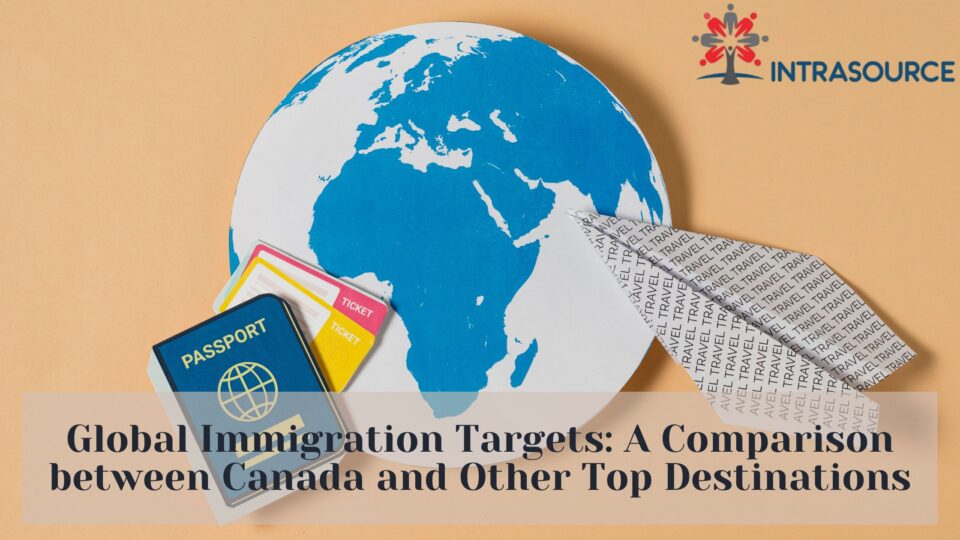The immigration landscape worldwide is quite diverse as different countries have their targets and priorities based on socioeconomic factors. In times Canada has consistently adopted a welcoming approach, towards immigration by increasing its targets. This article will compare Canadas immigration strategy with that of destinations for newcomers like the United Kingdom, Australia, the United States and New Zealand.
Canadas Strategy for Immigration
According to Canadas Immigration Levels Plan for 2024 2026 they have set a goal of welcoming 485,000 new immigrants in 2024. This will be followed by 500,000 immigrants, in both 2025 and 2026. The primary focus of this plan is to prioritize growth while also giving importance to family reunification and providing aid during crises.
By doing the Canadian government recognizes the significant role immigrants play in the labor market and overall economy. They aim to address skill gaps while also ensuring that Canada remains competitive at a level.
Comparing Top Immigrant Destinations
1) Australia’s Approach
Contrasting with Canada’s plan, Australia is looking to cut its annual immigration intake roughly by half by June 2025 to approximately 250,000, retreating to a pre-pandemic level. The intention behind this decision is to fix their “broken” immigration system by tightening visa rules and requirements for international students and low-skilled workers. This will include stricter English-language requirements for students and increased scrutiny for those applying for second visas.
2) United States’ Stance
The United States’ immigration policy has seen significant fluctuations over recent years. The current administration has expressed intentions to expand pathways for legal immigration while addressing undocumented immigration issues. However, US policies remain complex and subject to ongoing debates regarding border security and legal pathways for migrants.
3) United Kingdom (UK)
Post-Brexit immigration policies in the UK have introduced a points-based system, targeting skilled workers and attempting to reduce overall numbers of low-skilled workers. The UK government aims to attract top talent globally, taking into account qualifications, work experience, and language proficiency. This shift in policy is expected to lead to a reduced overall number of immigrants compared to past levels.
4) New Zealand (NZ)
New Zealand’s immigration strategy is under continuous review as the nation tries to strike a balance between maintaining the economic benefits of immigration and addressing housing shortages and infrastructure challenges exacerbated by population growth. While New Zealand has traditionally been welcoming, future policies may suggest restrictions on certain categories of immigrants to cater to the country’s growing needs.
The UK Government Implements Stricter Visa Regulations
According to a report, by BBC News the UK government has set its sights on reducing migration by implementing stricter regulations for obtaining work and family visas. Prime Minister Rishi Sunak has expressed concerns about the rates of migration in the region. To address this issue one of the proposed measures is to increase the minimum salary requirement for immigrants who wish to work in the UK.
New Zealand’s Prime Minister Focused on Sustainable Immigration Levels
Prime Minister Christopher Luxon expressed his desire for a more sustainable approach to immigration in New Zealand. The country is currently experiencing rising rents, house prices, and potential inflation due to a surge in new arrivals. Although specific policies have not been disclosed, Luxon aims to strike a balance and adjust the nation’s immigration stance over the next few months.
Cato Institute Emphasizes US Immigration System Constraints
A recent report by the Cato Institute claims that the US’s “outdated” immigration system hinders workforce expansion. The US has seen a decline in its contribution to worldwide immigrant population growth (from 63% down to -0.3%). Skilled immigrant workers account for up to 40% of total factor productivity growth; therefore, strict immigration policies could impede economic progress. The institute also points out that the US’s low green card caps have not been updated since 1990 and now ranks among the bottom third of wealthy countries in terms of its foreign-born population share.
Implications for Aspiring Immigrants Globally
In light of the analysis presented in this article, it is evident that out of the five countries discussed, Canada stands as the sole nation not planning substantial reductions to its immigration objectives in the near future. Various factors contribute to other popular immigration destinations, including countries with numerous foreign workers and international students, intending to decrease overseas migration for a short period.
While each nation’s strategic approach and immigration policies remain subject to change, those considering relocating to one of these sought-after destinations should not underestimate the significance of federal immigration policy. This is especially true when assessing their prospects for employment, education, or living in another country.
Nonetheless, individual aspirations will primarily dictate the choice to relocate to a specific destination. Bearing this in mind, potential immigrants should commit to extensive research that allows them to identify the location best suited to fulfilling their immediate and long-term personal and professional objectives.


